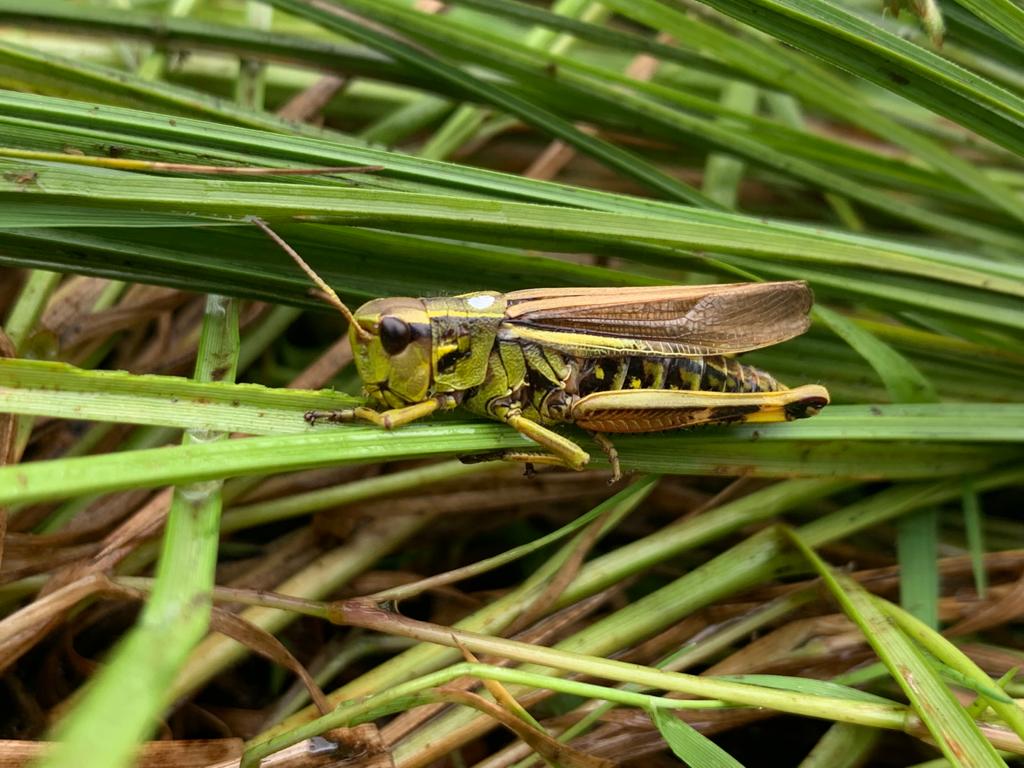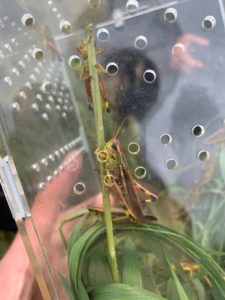


It was an exciting time in August when Large Marsh Grasshoppers were released at a private location here at Wild Ken Hill.
The Large Marsh Grasshopper is the largest of British grasshoppers but, unfortunately, also one of the rarest. It has extremely striking looks, appearing in a vibrant mix of pink and yellow.
It fares best in wet fens and peat bogs – sadly the widespread degradation and loss of these habitats over the past 100 years have led to a drastic contraction of the species’ range. Today, it survives almost exclusively in the valley mires and wet heaths of the New Forest and Dorset, but its former distribution included wetland habitats across Norfolk and the Cambridgeshire fens.
The release at Wild Ken Hill took place on a cloudy afternoon in August. The “hoppers” arrived with their “keepers” (more on this later) in small plastic containers, before bouncing off into the dense, wet vegetation that previous reconnaissance had suggested was going to be the best habitat for them.
A total of 122 hoppers were released at Wild Ken Hill, out of a total of 1,058 released during 2021 as part of the wider project. We hope that the widespread habitat creation and enhancements that have taken place here over the past few years provide a healthy, nurturing environment for the recently released hoppers.
The best indication of their success will be if we can detect the animals next summer – if we hear the distinctive clicking noise made by the males, this would suggest that the introduced species will have completed its annual life cycle in the wild, overwintering as eggs, hatching in early summer and passing through four nymphal instars, before becoming adults.
Like all invertebrates, we hope that the Large Marsh Grasshoppers will add back to the flourishing ecosystems at Wild Ken Hill – in particular, they will break down and recycle organic matter with their micro-grazing and provide food for other animals as a prey species.
Speaking to Lloyd, the Conservation Leader & Ecologist here at Wild Ken Hill, who attended the release, he said “Without human intervention, these creatures would likely become extinct in the UK. We need to restore creatures great and small to our natural landscape, so we are thrilled to be part of this important step (or should that be “hop”) in the recovery and conservation of Large Marsh Grasshoppers. The way we manage wetter areas here at Ken Hill should provide them with everything they need to become an established important part of the site’s ecology”
The release at Wild Ken Hill forms part of a wider partnership project called A Hop of Hope, led by Citizen Zoo and involving Norfolk Wildlife Trust, the Wildlife Trust for Beds, Cambs & Northants and Natural England. Before the release at Wild Ken Hill, the partnership had already released 2,152 “hoppers” – mainly adults but a few still at nymph stage – into secret sites in the Norfolk countryside.
To do this, Citizen Zoo safely collected a limited number of wild grasshoppers at several sites in the New Forest in 2018, where half were introduced directly at a wetland site in Norfolk. The rest were brought into captivity and allowed to breed in carefully controlled conditions, where they laid more eggs than they would have done in the wild. These eggs were collected for hatching and home-rearing the following summer.

Hoppers before release
Citizen Zoo is an organisation dedicated to rewilding and community engagement with nature. What we love about working with Citizen Zoo is their involvement of everyday people in hands-on conservation. It’s so fantastic for connecting people with nature.
For example, on this project, the grasshoppers were kept by “Citizen Keepers”, volunteers across England. The keepers are required to feed the grasshopper nymphs every day with fresh grass. We’d like to take the opportunity to thank the Citizen Zoo team for their great work on this project, as well as all those involved from the other project teams – keep it up!
Lucas Ruzo, CEO at Citizen Zoo said of the release at Wild Ken Hill, “We’re thrilled to have released Large Marsh Grasshoppers at Wild Ken Hill this year. The site forms part of their historical range, they’re meant to be there and it’s exciting that they have now returned. We’ve also always admired the ambition and work that the team at Wild Ken Hill are driving forward. They’re pushing boundaries, challenging perspectives and helping to rewild the future, so we feel fortunate and thankful to be a part of that journey”
Stuart Green, Lead Entomologist at Citizen Zoo and the grasshopper expert for the project said, “Four volunteer Citizen Keepers released a total of 122 young adult Large Marsh Grasshoppers at 2 sites in marshy habitat at Wild Ken Hill. Each grasshopper was marked with a small spot of coloured oil paint, according to its release site, so their movement could be monitored. They seemed to be doing well when the site was checked 8 days after release. Hopefully, by now they will have laid eggs, which will over-winter and hatch into a new generation of Large Marsh Grasshoppers next Spring.”